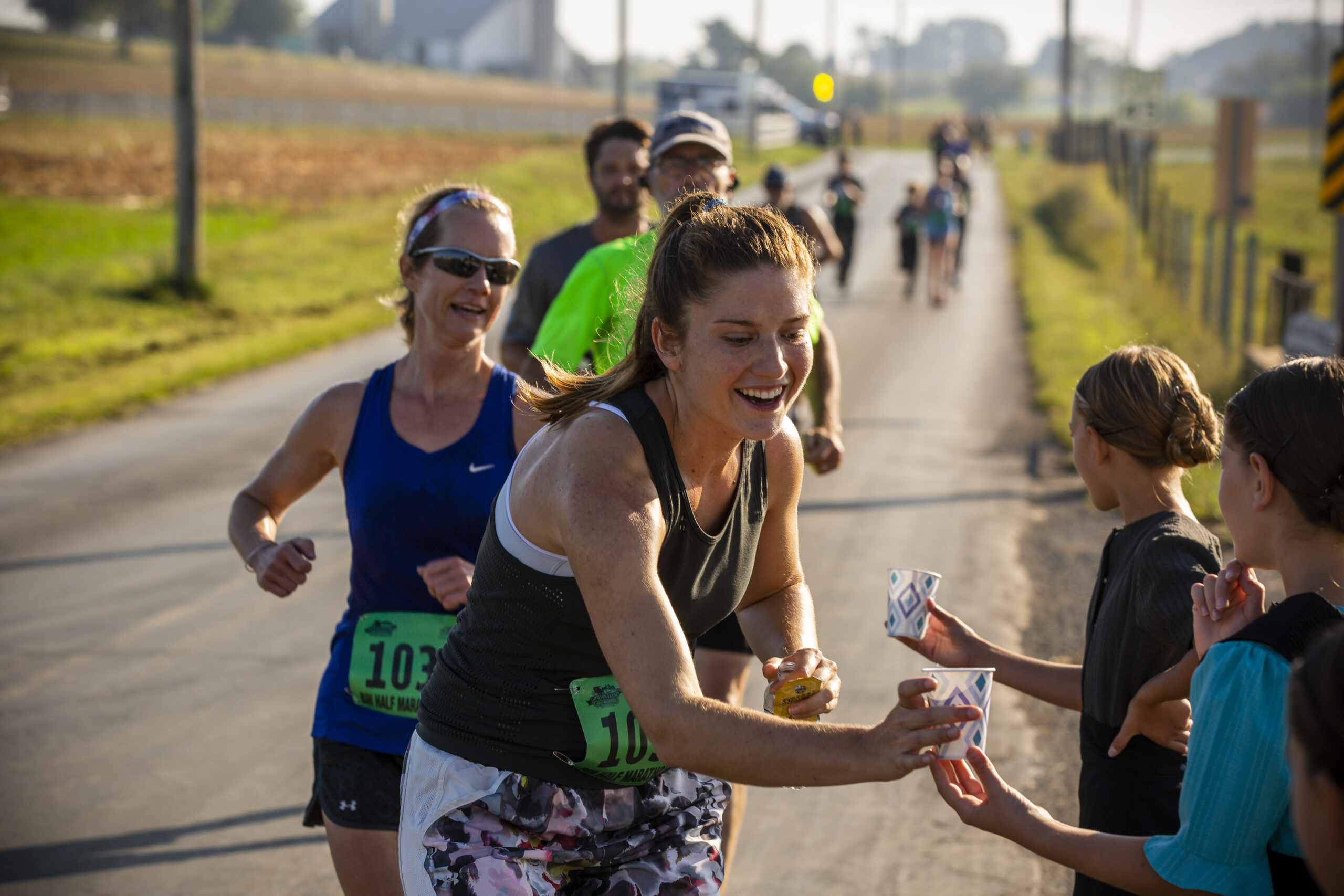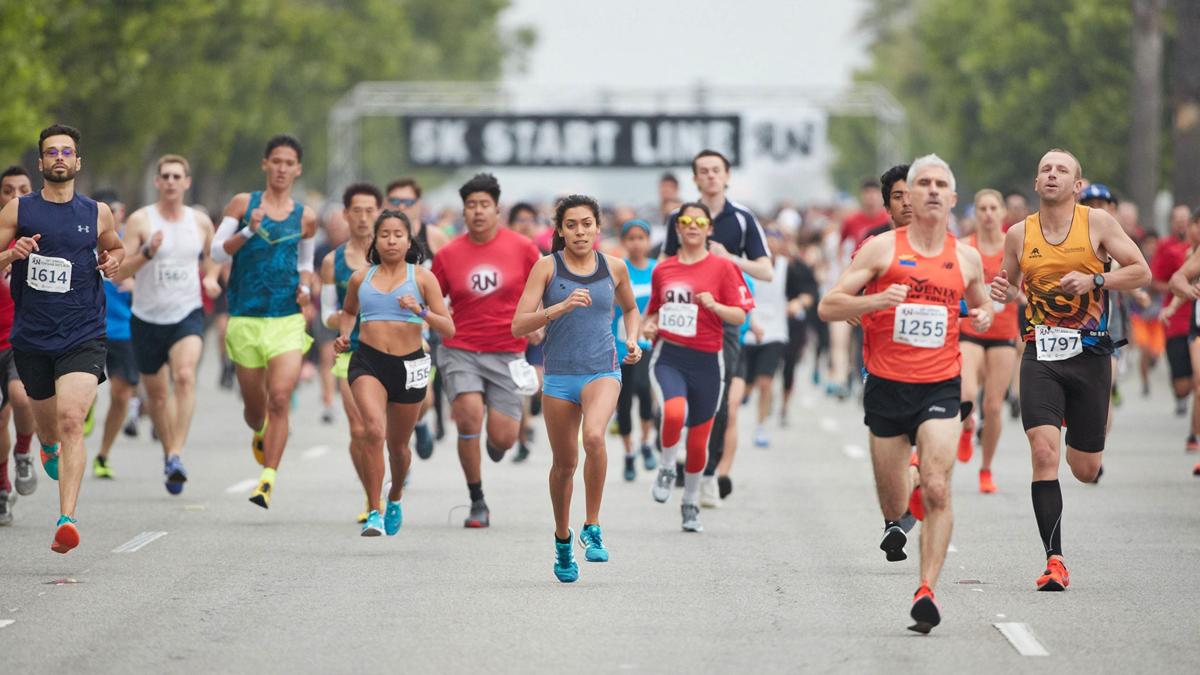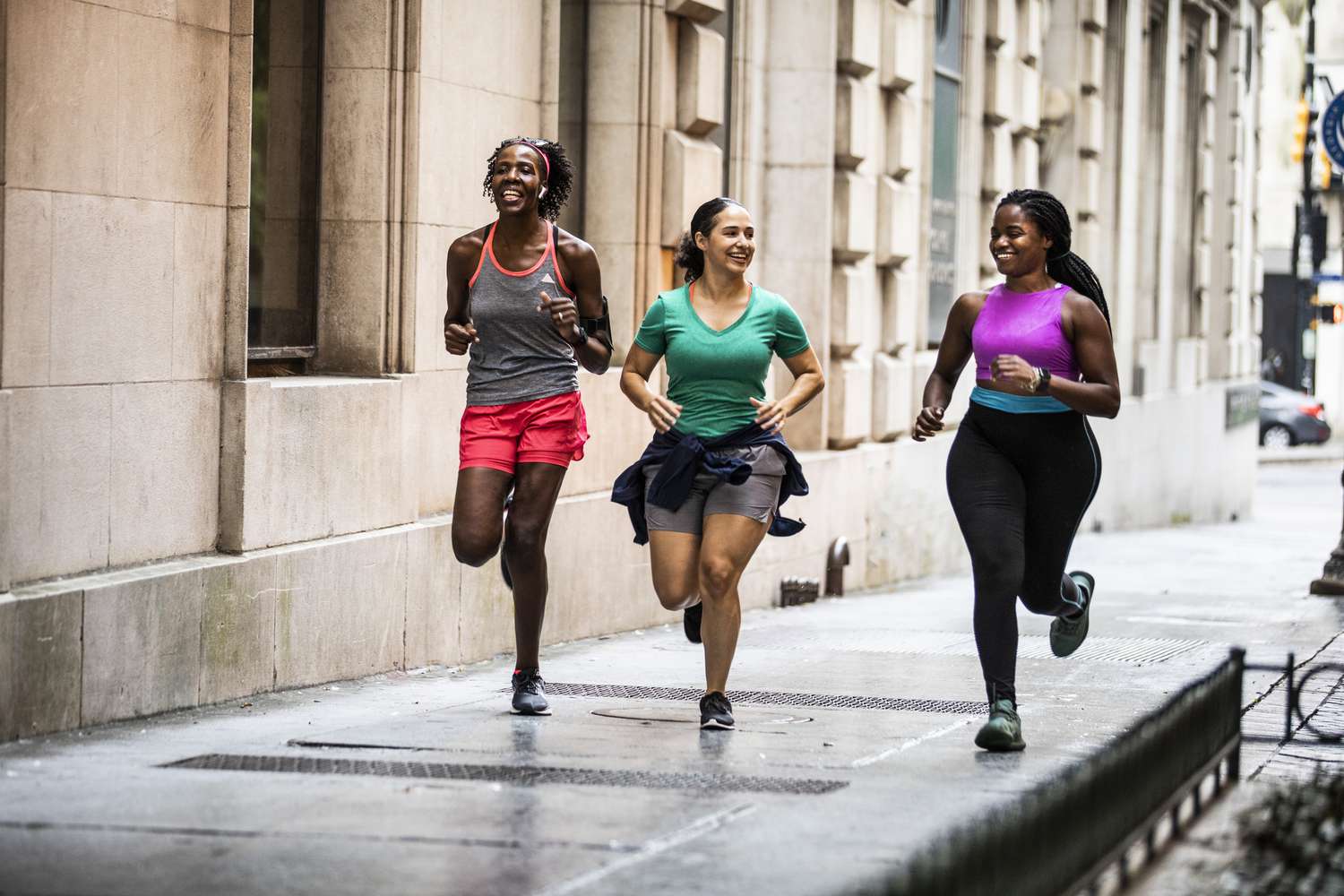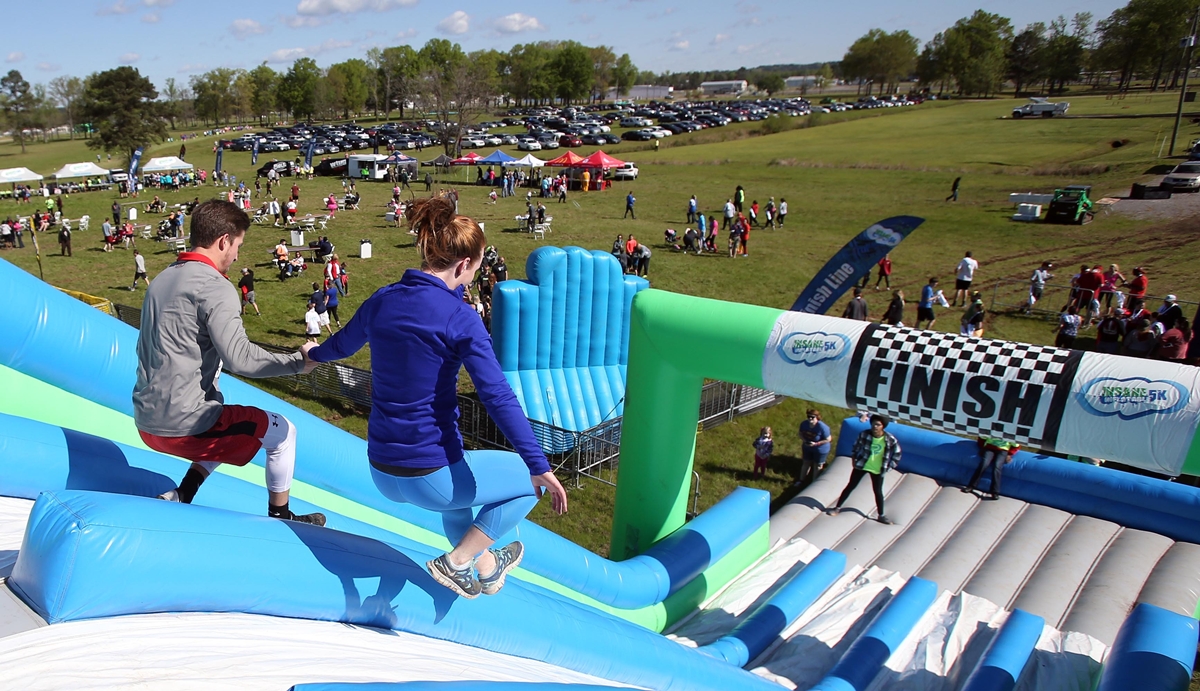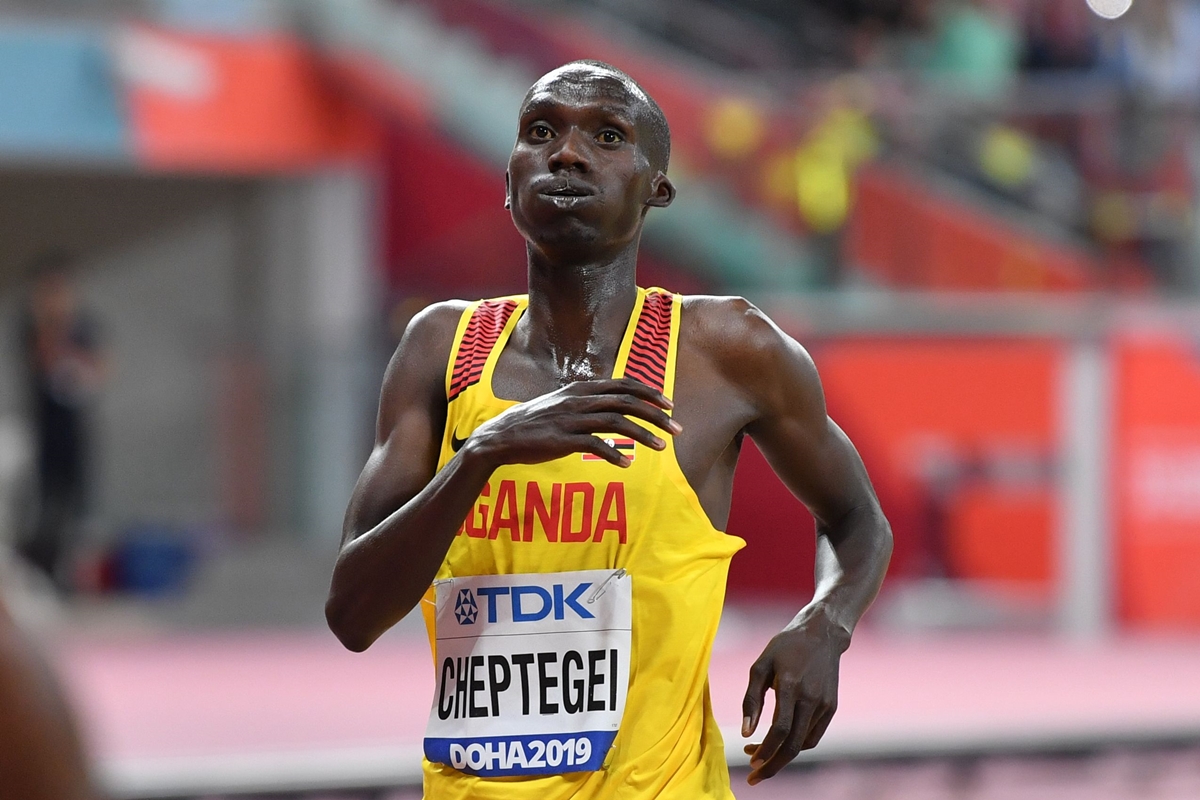

Featured
How To Train For 5K Run At 60 Years Old
Modified: January 22, 2024
Learn how to train for a 5K run at 60 years old with our featured tips and advice. Start your journey to fitness and conquer the race!
Introduction
Training for a 5K run can be a rewarding and exhilarating experience at any age, including when you’re 60 years old. Engaging in regular exercise is crucial for maintaining a healthy lifestyle, especially as we age. Running is an excellent form of cardiovascular exercise that improves overall fitness, boosts mental well-being, and can even increase longevity.
As we get older, it’s essential to adapt our training approach to meet the unique needs of our bodies. While it’s natural for our physical capabilities to change over time, it doesn’t mean we have to forego our aspirations of accomplishing a 5K run. With the right training plan, mindset, and preparation, you can achieve your goals and feel the exhilaration of crossing that finish line.
This article will guide you through the process of training for a 5K run at 60 years old. We will discuss the importance of exercise for aging adults, provide practical tips on building endurance, explain how to incorporate interval training, discuss strength training exercises, emphasize the importance of flexibility and stretching, and provide guidance on proper nutrition, hydration, rest, and recovery. Additionally, we will address injury prevention and management, offer a sample training schedule, and highlight the significance of monitoring your progress. Finally, we will discuss the psychological aspects of preparation and offer some encouragement to help you stay motivated throughout your training journey.
Importance of Exercise for Aging Adults
Exercise is crucial for maintaining physical and mental well-being as we age. Regular physical activity has numerous benefits, including improving cardiovascular health, strengthening muscles and bones, reducing the risk of chronic conditions, and enhancing overall quality of life.
Engaging in exercise as an aging adult can help maintain muscle mass and strength, which tend to decline with age. This is particularly important as muscle strength plays a significant role in maintaining balance, preventing falls, and ensuring independence in daily activities.
Exercise also has a positive impact on cognitive function and mental health. It can help reduce the risk of cognitive decline and dementia, improve memory and concentration, and boost mood and overall mental well-being. Additionally, regular exercise has been shown to reduce the symptoms of anxiety and depression, providing a natural and effective way to manage these conditions.
Moreover, staying physically active can help manage chronic conditions commonly associated with aging, such as heart disease, diabetes, and arthritis. Exercise can help control blood pressure, improve blood sugar regulation, and alleviate joint stiffness and pain. It can also enhance the immune system, making the body more resilient to infections and illnesses.
Engaging in regular exercise also promotes healthy weight management. As metabolism naturally slows down with age, maintaining a healthy weight becomes more challenging. Exercise helps burn calories, build lean muscle mass, and increase metabolism, making weight management more attainable.
Additionally, exercise improves cardiovascular health by strengthening the heart muscle and enhancing circulation. It increases lung capacity, supports efficient oxygen delivery, and reduces the risk of heart disease and stroke.
Overall, exercise is a powerful tool for promoting physical and mental well-being in aging adults. It is important to remember that it’s never too late to start incorporating physical activity into your routine. Whether you’re already active or just beginning, it’s essential to consult with your doctor before starting any new exercise program to ensure it is safe and appropriate for your individual needs.
Understanding the 5K Run
The 5K run, also known as a 5-kilometer race, is a popular distance for runners of all ages and abilities. It is equivalent to approximately 3.1 miles. The 5K distance is a common choice for beginners and experienced runners alike, offering a manageable challenge that can be completed within a reasonable time frame.
Participating in a 5K run provides an opportunity to set and accomplish a fitness goal, improve cardiovascular endurance, and experience the sense of accomplishment that comes with crossing the finish line.
One of the great things about the 5K distance is that it is versatile. It can be completed at a variety of paces, including walking, jogging, and running. This makes it accessible to people of all fitness levels, allowing individuals to challenge themselves while still enjoying the experience.
The 5K run typically takes place on a marked course, often in a community setting, such as a park or city streets. Participants start at a designated point and follow the route, which may include hills, turns, and various terrains.
Many 5K races are organized as fundraisers for charitable causes, giving participants the opportunity to contribute to a worthy cause while engaging in physical activity.
Participants in a 5K run can expect to experience a range of emotions and physical sensations throughout the race. The adrenaline and excitement at the start line, the steady rhythm of breathing and footsteps during the race, and the surge of energy and satisfaction when approaching the finish line are all part of the unique experience.
It’s important to remember that the 5K run is a personal journey. While some participants strive to achieve a specific time goal or compete against others, many individuals participate purely for the joy of the experience. The focus should be on setting personal goals, improving fitness, and enjoying the process.
No matter your age or fitness level, training for and completing a 5K run can be a significant achievement. It’s a chance to challenge yourself, stay motivated, and experience the benefits of regular exercise in a fun and supportive environment.
Consultation with a Doctor
Before embarking on any new exercise program, it’s crucial for individuals, especially those who are 60 years old or older, to consult with their doctor. A consultation with a healthcare professional ensures that you are physically capable of participating in a 5K run and can help identify any potential health risks or considerations.
Your doctor will be able to assess your overall health, evaluate your medical history, and conduct necessary tests to determine if there are any underlying conditions that may affect your ability to train for a 5K run. This is particularly important if you have any existing chronic conditions, such as heart disease, diabetes, or arthritis.
During the consultation, be prepared to discuss any medications you are taking, as well as any symptoms you may be experiencing during exercise or physical activity. Your doctor may also inquire about your fitness level, lifestyle habits, and goals to better tailor their recommendations to your specific needs.
The doctor’s recommendations may vary depending on individual circumstances. They may provide general guidelines for exercise, suggest modifications based on any pre-existing conditions, or recommend additional tests or consultations with specialists if needed.
Some individuals may require a stress test or other diagnostic assessments to evaluate their cardiovascular health. This helps to ensure that the heart is capable of handling the physical demands of training for a 5K run.
Additionally, if you have any joint issues, such as arthritis, your doctor may suggest modifications to your training plan or recommend specific exercises to protect your joints and prevent further damage.
The primary purpose of consulting with a doctor is to ensure your safety and well-being during the training process. By discussing your intentions and receiving professional advice, you can proceed with confidence knowing that you are taking the necessary precautions for your individual health.
Remember, your doctor is there to support you and provide guidance on how to best navigate your journey towards training for a 5K run. Their expertise will help ensure that you approach your training in a way that suits your unique circumstances and promotes both physical and mental well-being.
Setting Realistic Goals
Setting realistic goals is an essential step in training for a 5K run, especially for individuals who are 60 years old or older. It’s important to establish goals that are challenging yet achievable to maintain motivation and prevent injury.
When setting goals, consider your current fitness level, any previous running experience, and your overall health. Be honest with yourself about your capabilities and limitations. By setting realistic goals, you will be able to progress steadily and avoid overexertion or burnout.
Start by setting a primary goal for your 5K run. This could be completing the race within a specific time frame, finishing without walking, or simply crossing the finish line and enjoying the experience. Remember that everyone’s goals are personal, and what matters most is that you feel accomplished and satisfied with your performance.
In addition to your primary goal, consider setting smaller, incremental goals to help you stay motivated and track your progress. These could include running a specific distance without stopping, improving your pace by a certain amount, or increasing the number of training sessions per week.
It is also important to give yourself enough time to train and prepare for the 5K run. Setting a realistic timeline ensures that you have sufficient opportunity to build up your endurance and stamina gradually. Rushing the training process increases the risk of injury and can lead to frustration and disappointment.
Remember that your goals can evolve throughout your training journey. As you progress and gain confidence, you may choose to adjust your goals to be more ambitious. However, always make sure to maintain a balance between pushing yourself and listening to your body’s needs.
Lastly, celebrate your accomplishments along the way. Recognize and appreciate the smaller milestones you achieve during your training, such as running a longer distance or improving your pace. Rewarding yourself for your hard work and dedication can help maintain motivation and make the training process more enjoyable.
By setting realistic goals, you will create a roadmap for your training and provide yourself with direction and purpose. Remember to be flexible and adjust your goals as needed, and most importantly, enjoy the journey towards your 5K run.
Building Endurance and Stamina
Building endurance and stamina is a critical aspect of training for a 5K run, especially for individuals who are 60 years old or older. Increasing your cardiovascular fitness and improving your body’s ability to sustain physical activity over a prolonged period is key to successfully completing a 5K run.
Here are some effective strategies to help you build endurance and stamina:
1. Start with a Walk-Run Approach: If you’re new to running or haven’t been active for a while, begin by incorporating periods of walking and running into your training. Gradually increase the duration and frequency of running intervals while reducing the walking intervals over time.
2. Follow the 10% Rule: Increase your weekly mileage or running time by no more than 10% each week to avoid overtraining and minimize the risk of injury. Slow and steady progress is key to building endurance safely.
3. Incorporate Long Runs: Designate one day a week for a longer run, gradually increasing your distance over time. Focus on maintaining a comfortable pace and aim to complete the entire distance without stopping. This helps build both physical and mental endurance.
4. Implement Interval Training: Intervals involve alternating between periods of higher intensity and recovery. Incorporating interval training into your routine helps improve your cardiovascular conditioning and enhances your body’s ability to withstand sustained effort. For example, try alternating between one minute of running at a challenging pace and one minute of walking or jogging to recover. Gradually increase the running intervals as you become stronger.
5. Practice Tempo Runs: Tempo runs involve running at a comfortably hard pace for an extended period. Aim to sustain this pace for 15-20 minutes, gradually increasing the duration as your fitness improves. Tempo runs help improve your running economy and increase your lactate threshold.
6. Focus on Consistency: Regularity is key when it comes to building endurance and stamina. Make running a part of your weekly routine and aim for at least three to four sessions per week. Consistency will allow your body to adapt and progress steadily.
7. Listen to Your Body: Pay attention to your body’s signals and adjust your training as needed. Rest and recovery days are just as important as the training itself. Give your body time to recover and repair to avoid overtraining and injury.
Remember that building endurance takes time and patience. Be kind to yourself and celebrate the small victories along the way. With consistent training and a gradual increase in effort, you will improve your endurance and stamina, setting yourself up for success in your 5K run.
Incorporating Interval Training
Interval training is a highly effective method for improving cardiovascular fitness, increasing speed, and enhancing endurance when training for a 5K run. It involves alternating between periods of higher intensity exercise and active recovery. Incorporating interval training into your training routine can help individuals who are 60 years old or older build endurance and stamina more efficiently.
Here are some tips for incorporating interval training into your 5K run training:
1. Warm Up Properly: Before starting any intense exercise, ensure you warm up properly. This may include five to ten minutes of light jogging, brisk walking, or dynamic stretching to prepare your muscles and joints for the workout ahead.
2. Start with Short Intervals: Begin with shorter intervals of higher intensity running, followed by active recovery periods. For example, you could start with 30 seconds of running at a faster pace, followed by one to two minutes of walking or jogging to recover. Gradually increase the duration of your running intervals as your fitness improves.
3. Vary the Intensity: Experiment with different speeds and intensities during your running intervals. You can try running at a comfortably challenging pace, just above your normal running speed. As you progress, increase the intensity to a faster pace or incorporate sprinting intervals to challenge yourself further.
4. Adjust Work-to-Rest Ratio: The work-to-rest ratio refers to the duration of the running interval compared to the recovery period. You can experiment with different ratios, such as 1:1 (equal work and rest) or 2:1 (twice as much work as rest). Choose a ratio that challenges you while still allowing for adequate recovery.
5. Use a Run-Walk Approach: If running for longer intervals is challenging, you can incorporate a run-walk approach during interval training. For example, you can alternate between one-minute running intervals and one-minute walking intervals. Gradually increase the duration of your running intervals as your endurance improves.
6. Incorporate Hill Sprints: Including hill sprints in your interval training can be an effective way to build both cardiovascular endurance and leg strength. Find a hill with a moderate incline and sprint up it for a short distance, then walk or jog back down to recover before repeating. As you become more accustomed to the intensity, increase the number of hill sprints or the distance covered.
7. Monitor and Progress: Keep track of your interval training sessions to monitor your progress. Record the duration, intensity, and recovery times for each interval. It can be motivating to see your improvements over time and adjust your future interval workouts accordingly.
8. Listen to Your Body: As with any training technique, it’s essential to listen to your body and adjust the intensity and duration of your intervals based on how you feel. If you experience pain or discomfort, reduce the intensity or take longer recovery periods to avoid overexertion or injury.
Interval training provides a way to challenge and improve your cardiovascular fitness while allowing for adequate rest and recovery. It can be customized to suit your current fitness level and gradually progressed over time as your endurance and stamina improve. By incorporating interval training into your 5K run training routine, you can enhance your overall performance and reach your goals effectively.
Strength Training Exercises
Incorporating strength training exercises into your training program for a 5K run is essential for individuals who are 60 years old or older. Strength training helps maintain and build muscle mass, improve bone density, enhance overall strength, and reduce the risk of age-related muscle loss and injuries.
Here are some key strength training exercises to consider:
1. Squats: Squats are a compound exercise that targets multiple muscle groups, including the quadriceps, hamstrings, glutes, and core. Stand with your feet shoulder-width apart, lower your body as if you were sitting back into an imaginary chair, and then push through your heels to return to the starting position.
2. Lunges: Lunges also engage multiple muscles, particularly the quadriceps, hamstrings, glutes, and calf muscles. Take a step forward with one foot, lowering your body until both knees are bent at a 90-degree angle. Push through the heel of your front foot to return to the starting position, and then repeat on the other side.
3. Step-ups: Step-ups help strengthen the lower body, including the quadriceps, hamstrings, and glutes. Find a stable platform or bench and step onto it with one foot, lifting your body up and bringing the opposite knee up towards your chest. Step back down and repeat with the opposite foot.
4. Push-ups: Push-ups are an effective exercise for targeting the chest, shoulders, triceps, and core. Start in a plank position with your hands slightly wider than shoulder-width apart. Lower your body by bending your elbows, keeping your core engaged, and then push back up to the starting position.
5. Planks: Planks are an excellent exercise for core strength. Begin in a push-up position, then lower your forearms to the floor, keeping your elbows under your shoulders. Hold the position, keeping your body in a straight line from head to toe, engaging your core muscles.
6. Dumbbell or Resistance Band Exercises: Incorporate dumbbell or resistance band exercises to target specific muscle groups. Bicep curls, tricep extensions, shoulder presses, and rows are all effective ways to build upper body strength. Start with light weights or resistance bands and gradually increase the intensity as your strength improves.
7. Balance Exercises: As we age, it becomes important to work on improving balance and stability. Consider incorporating exercises such as single-leg stands, heel-to-toe walks, or yoga poses like tree pose or warrior pose to enhance your balance and proprioception.
8. Don’t Forget Core Exercises: Strengthening the core is crucial for overall stability and posture. Planks, side planks, Russian twists, and bird dogs are all effective exercises for targeting the core muscles.
When incorporating strength training into your 5K run training program, aim for two to three sessions per week. Allow at least 48 hours of rest between sessions to allow for muscle recovery. It’s important to start with lighter weights or resistance bands and progress gradually to avoid strain or injury.
By incorporating strength training exercises into your routine, you will improve your overall strength, stability, and muscle endurance. This will not only enhance your performance during the 5K run but also provide long-term benefits for your overall health and well-being.
Flexibility and Stretching
Flexibility and stretching play a crucial role in any training program, especially for individuals who are 60 years old or older. Incorporating regular stretching exercises can improve joint mobility, prevent muscle stiffness, enhance performance, and reduce the risk of injuries during your 5K run.
Here are some key points to consider when it comes to flexibility and stretching:
1. Warm-up Before Stretching: It’s important to warm up your muscles before engaging in stretching exercises. This can be done through light aerobic activity, such as walking or jogging in place, for a few minutes. Warming up increases blood flow to the muscles, preparing them for stretching and reducing the risk of injury.
2. Dynamic Stretching: Dynamic stretching involves moving your joints and muscles through their full range of motion in a controlled manner. These movements help warm up the muscles and prepare them for activity. Examples of dynamic stretches include leg swings, arm circles, and walking lunges. Perform dynamic stretches before your run to improve flexibility and mobility.
3. Static Stretching: Static stretching involves stretching a muscle to the point of slight discomfort and holding it in that position for 20-30 seconds without bouncing. Static stretching is best done after your workout or cool-down to maintain or improve flexibility. Focus on stretching the major muscle groups used during running, such as the calves, quadriceps, hamstrings, and hip flexors.
4. Gentle and Controlled Movements: When performing static stretches, remember to use gentle and controlled movements. Avoid bouncing or jerking, as it can strain the muscles. Instead, relax into the stretch and gradually increase the depth as your muscles start to loosen up.
5. Focus on Problem Areas: Pay attention to areas of your body that tend to be tight or prone to stiffness. If you have specific areas that require extra attention, such as tight hips or shoulders, incorporate targeted stretches into your routine to address those areas specifically.
6. Mindful Breathing: While stretching, focus on deep, controlled breathing. Inhale deeply through your nose and exhale through your mouth. Deep breathing helps promote relaxation and allows for deeper stretching.
7. Regularity and Consistency: Incorporating flexibility and stretching exercises into your routine should be done regularly and consistently to maintain or improve flexibility over time. Aim to stretch at least three to four times a week, if not more, to see significant improvements.
8. Listen to Your Body: Pay attention to how your body responds during stretching exercises. Stretching should create a gentle pulling sensation in your muscles but should never be painful. If you feel any pain or discomfort, ease off the stretch slightly to avoid injury.
9. Consider Other Practices: In addition to traditional stretching exercises, consider incorporating other practices such as yoga or Pilates into your routine. These activities can improve flexibility, strength, and overall body awareness.
By incorporating flexibility and stretching exercises into your training program, you’ll improve your overall range of motion, reduce muscle soreness, improve circulation, and enhance your performance during the 5K run. Remember to take your time and be consistent with your stretching routine for the best results.
Proper Nutrition and Hydration
Proper nutrition and hydration play a vital role in fueling your body and supporting your training efforts for a 5K run, especially for individuals who are 60 years old or older. By maintaining a well-balanced diet and staying properly hydrated, you can optimize your performance, aid in recovery, and support your overall health and well-being.
Here are some key considerations when it comes to nutrition and hydration:
1. Eat a Balanced Diet: Focus on consuming a nutritious and well-balanced diet that includes a variety of foods from all food groups. Include lean proteins, whole grains, fruits, vegetables, and healthy fats in your meals to provide your body with essential nutrients.
2. Prioritize Complex Carbohydrates: Carbohydrates are the primary fuel source for running. Prioritize complex carbohydrates such as whole grains, fruits, and vegetables, which provide sustained energy throughout your training. Aim to include these foods in your meals leading up to your 5K run.
3. Include Protein for Recovery: Protein is essential for muscle repair and recovery. Include lean sources of protein such as chicken, fish, legumes, tofu, or Greek yogurt in your diet to support muscle growth and repair after your training sessions.
4. Adequate Hydration: Staying properly hydrated is crucial for optimal performance. Ensure you drink enough water throughout the day, both during training and in regular daily activities. Aim to consume at least 8-10 cups (64-80 ounces) of water per day, more if you are engaging in intense physical activity. Listen to your body’s thirst cues and drink water before, during, and after your runs to maintain hydration.
5. Electrolyte Balance: Electrolytes, such as sodium, potassium, and magnesium, are essential for maintaining fluid balance and muscle function. Consider incorporating electrolyte-rich foods such as bananas, oranges, avocados, and nuts into your diet. Additionally, during more extended or intense training sessions, you may benefit from consuming electrolyte-enhanced sports drinks or gels to replenish electrolytes lost through sweat.
6. Timing of Meals and Snacks: Pay attention to the timing of your meals and snacks to fuel your workouts appropriately. Eat a balanced meal containing carbohydrates, proteins, and fats within 1-2 hours before your training sessions. For longer training sessions, incorporate small snacks, such as energy bars or fruits, to maintain energy levels during the run.
7. Post-Run Nutrition: After completing your 5K run, prioritize refueling your body with a combination of carbohydrates and protein. This aids in muscle recovery and glycogen replenishment. Consider a snack or meal that includes fruits, whole grains, lean protein, and some healthy fats.
8. Nutritional Supplements: While a well-balanced diet should provide most of the nutrients you need, some individuals may benefit from certain supplements. Discuss the need for any supplements, such as vitamins or minerals, with your doctor or a registered dietitian to ensure they are appropriate for your individual needs.
Remember, every individual has unique nutritional needs, so it’s crucial to listen to your body and make adjustments accordingly. Consulting with a registered dietitian can provide personalized guidance and ensure you’re meeting your nutritional requirements while training for your 5K run.
Rest and Recovery
Rest and recovery are crucial components of any training program, especially for individuals who are 60 years old or older. Allowing your body time to rest and recover is essential for preventing injuries, avoiding burnout, and optimizing performance during your 5K run.
Here are some important considerations when it comes to rest and recovery:
1. Plan Rest Days: Incorporate regular rest days into your training schedule. Rest days give your muscles time to repair and rebuild, reducing the risk of overuse injuries. Use this time to engage in light activities, such as walking or gentle stretching, to promote blood flow and aid in recovery.
2. Listen to Your Body: Pay attention to how your body feels and adjust your training as needed. If you experience excessive fatigue or pain, consider taking additional rest days or reducing the intensity of your workouts. Pushing through significant discomfort can lead to injuries and hinder your progress.
3. Sleep Well: Quality sleep is essential for recovery and overall well-being. Aim for 7-9 hours of restful sleep per night. Establishing a soothing bedtime routine, creating a comfortable sleep environment, and avoiding electronic devices before bed can all contribute to better sleep quality.
4. Active Recovery: Incorporate active recovery activities on your rest days. Engage in low-impact exercises, such as swimming, cycling, or gentle yoga, to promote blood flow and aid in muscle recovery. These activities can also help improve flexibility, reduce muscle soreness, and promote relaxation.
5. Listen to Your Joints: As you age, it’s important to pay attention to how your joints feel during and after exercise. If any joint pain or discomfort persists, consult with a healthcare professional to address any underlying issues or modify your training routine accordingly.
6. Foam Rolling and Stretching: Utilize foam rolling and stretching exercises to release muscle tension and improve flexibility. Foam rolling can help alleviate muscle soreness and increase blood flow to targeted areas. Stretching can help reduce muscle tightness and improve range of motion.
7. Hydrate and Nourish Properly: Proper hydration and nutrition are vital for recovery. Drink plenty of water throughout the day to stay hydrated, replenish electrolytes if necessary, and consume a balanced diet that includes carbohydrates, proteins, and healthy fats to support muscle repair and glycogen replenishment.
8. Cross-Train: Incorporate cross-training activities into your routine to reduce the impact on specific muscle groups and joints. Activities such as swimming, cycling, or strength training can provide a well-rounded fitness routine while giving specific muscle groups a break.
Remember, rest and recovery are not signs of weakness but essential components of a successful training program. By allowing your body time to recover, you’re giving it the opportunity to adapt and grow stronger, ultimately improving your performance and reducing the risk of injuries as you train for your 5K run.
Injury Prevention and Management
Injury prevention and management are critical considerations when training for a 5K run, particularly for individuals who are 60 years old or older. By taking proactive steps to prevent injuries and effectively managing any that may occur, you can ensure a safe and successful training experience.
Here are some essential strategies for injury prevention and management:
1. Warm-Up and Cool-Down: Start each training session with a proper warm-up to increase blood flow to your muscles and prepare them for activity. Incorporate dynamic stretches and light aerobic exercises to warm up your body. After your run, cool down with gentle walking and static stretching to promote muscle recovery.
2. Gradual Progression: Avoid sudden increases in mileage, intensity, or training frequency. Gradual progression allows your body to adapt to the demands of running and reduces the risk of overuse injuries. Stick to the “10% rule” – increase your mileage or intensity by no more than 10% each week.
3. Proper Footwear: Invest in a pair of well-fitting running shoes that provide adequate support and cushioning. Replace your shoes every 300-500 miles or when you notice signs of wear and tear. Consider getting fitted by a professional at a running specialty store to ensure you have the right shoes for your foot type and running mechanics.
4. Strength Training: Incorporate strength training exercises into your routine to build the strength of your muscles and reduce the risk of injuries. Focus on strengthening the muscles around your hips, knees, and ankles, as these areas are commonly prone to injury in runners.
5. Listen to Your Body: Pay attention to any warning signs from your body, such as pain, discomfort, or unusual sensations. If you experience persistent or worsening pain, it’s important to back off or modify your training. Pushing through pain can lead to more severe injuries.
6. Cross-Training: Include cross-training activities in your routine to reduce the repetitive impact on your joints and muscles. Activities such as swimming, cycling, or low-impact aerobics can provide cardiovascular benefits while giving your running muscles a break.
7. Rest and Recovery: Allow for adequate rest and recovery between training sessions. Rest days give your body time to repair and rebuild, reducing the risk of overuse injuries. Listen to your body and adjust your training schedule as needed to ensure you are getting sufficient rest.
8. Seek Professional Guidance: If you experience a persistent or severe injury, don’t hesitate to seek professional guidance from a healthcare provider or a sports medicine specialist. They can assess your injury, provide a diagnosis, and recommend appropriate treatment and rehabilitation strategies.
9. Practice Good Body Mechanics: Maintain proper running form, including a relaxed posture, a slight forward lean from the ankles, and a midfoot landing. Avoid overstriding, which can lead to excessive stress on the joints. Practicing good body mechanics can help prevent injuries and improve running efficiency.
10. Listen to Professional Advice: If you are experiencing recurring injuries or have specific concerns about your training, consider seeking guidance from a running coach or physical therapist with experience in working with older runners. They can provide guidance on technique, training modifications, and specific exercises to address weaknesses or imbalances.
By following these injury prevention and management strategies, you can minimize the risk of injuries and ensure a safe and enjoyable training experience as you work towards completing your 5K run.
Training Schedule for a 5K Run
Having a well-structured training schedule is essential when preparing for a 5K run, especially for individuals who are 60 years old or older. A proper training plan progressively builds your endurance, improves your running technique, and helps you reach your goal safely and effectively.
Here is a sample 8-week training schedule for a 5K run:
Week 1-2:
- Alternate between walking and jogging for 20-30 minutes, 3 times a week.
- Focus on gradually increasing your jogging intervals and reducing the walking intervals.
Week 3-4:
- Continue to alternate between jogging and walking, aiming for a total of 30-40 minutes of activity, 3 times a week.
- Increase the duration of your jogging intervals and decrease the duration of the walking intervals.
Week 5-6:
- Transition to running continuously for 25-30 minutes, 3 times a week.
- Focus on maintaining a steady pace and improving your running form.
Week 7:
- Increase the duration of your runs to 35-40 minutes, 3 times a week.
- Consider incorporating some interval training sessions, alternating between faster-paced running and recovery periods.
Week 8:
- Continue running for 35-40 minutes, 3 times a week.
- Include one longer run, gradually increasing the duration up to 45-50 minutes.
- Taper your training in the last few days before the race to allow your body to recover and prepare for the 5K run.
Remember to listen to your body throughout the training process. If you experience any pain or excessive fatigue, consider taking an extra rest day or reducing the intensity of your runs. Be flexible with the schedule and make adjustments as necessary to ensure that your training plan suits your individual needs and capabilities.
In addition to the running sessions, incorporate cross-training activities such as swimming, cycling, or strength training on non-running days to promote overall fitness and reduce the risk of overuse injuries. Remember to prioritize rest and recovery as well, allowing at least one or two rest days per week to allow your body to recover and avoid burnout.
Keep in mind that this training schedule is a general guideline and can be adjusted based on your current fitness level and capabilities. If you have any specific concerns or considerations, it’s advisable to consult with a running coach or healthcare professional for personalized guidance.
Monitoring Progress
Monitoring your progress is an essential part of training for a 5K run, particularly for individuals who are 60 years old or older. Tracking your progress allows you to assess the effectiveness of your training program, make necessary adjustments, and stay motivated throughout your journey. Here are some effective ways to monitor your progress:
1. Record Your Runs: Keep a training journal or use a mobile app to log your running sessions. Note the distance, duration, and perceived effort level of each run. This will help you track your improvement over time and identify any patterns or trends in your performance.
2. Track Your Pace: Monitor your running pace during each training session. You can use a GPS watch, a running app, or even basic timing to determine your pace per kilometer or mile. As your fitness improves, you should see your pace gradually improve or your ability to maintain a steady pace for longer durations.
3. Measure Your Heart Rate: Consider using a heart rate monitor to track your heart rate during runs. Monitoring your heart rate can provide valuable insights into the intensity of your workouts and help you determine your ideal training zones. Over time, you should notice improvements in your heart rate recovery and your ability to sustain higher intensities for longer periods.
4. Assess Energy and Fatigue Levels: Pay attention to your energy levels and how fatigued you feel during and after your runs. If you notice consistent improvements in energy and a reduced sense of fatigue, it’s a good indicator that your training is effective. Conversely, an increase in fatigue or a decline in energy levels may suggest that you need to adjust your training or incorporate more rest and recovery.
5. Take Regular Fitness Assessments: Periodically perform fitness assessments to gauge your progress. This can include measuring your running speed over a certain distance, testing your endurance by attempting longer runs, or checking your body composition. Fitness assessments provide objective data and can be motivating as you see improvements in your performance and physical fitness.
6. Listen to Your Body: Pay attention to how your body feels during and after your runs. Notice any changes in how you’re breathing, your perceived effort level, or any discomfort or pain. Positive changes, such as feeling more comfortable at a certain pace or experiencing less post-run soreness, can indicate progress. Conversely, persistent pain or excessive fatigue may indicate the need to adjust your training or seek professional advice.
7. Celebrate Milestones: Celebrate your achievements along the way, regardless of their size. Whether it’s running a longer distance, achieving a personal best time, or simply completing a challenging run, acknowledge and reward yourself for your hard work and dedication. Recognizing your progress boosts motivation and encourages continued success.
Remember that progress may not always be linear, and there will be ups and downs throughout your training journey. Be patient with yourself and focus on the overall improvement trends rather than short-term fluctuations. By monitoring your progress, you can make informed decisions about your training, stay motivated, and reach your goal of completing the 5K run.
Psychological Preparation
Psychological preparation is just as important as physical training when it comes to successfully completing a 5K run, especially for individuals who are 60 years old or older. Building mental resilience, maintaining motivation, and managing pre-race nerves are essential factors in achieving your goals. Here are some strategies to help with your psychological preparation:
1. Set Realistic Expectations: Start by setting realistic expectations for yourself. Recognize that progress takes time and that each individual has their own pace of improvement. Focus on personal achievements rather than comparing yourself to others.
2. Visualize Success: Use visualization techniques to mentally prepare for your 5K run. Imagine yourself crossing the finish line and experiencing the sense of accomplishment and joy. Visualizing success can enhance your motivation and boost your confidence.
3. Practice Positive Self-Talk: Develop a positive mindset by using self-affirmation and positive self-talk. Encourage and motivate yourself with affirmations such as “I am strong and capable” or “I can do this.” Replace negative thoughts with positive and empowering ones.
4. Break Down the Distance: The 5K distance can feel daunting, especially for beginners. Break down the distance into smaller, manageable milestones. Focus on completing each kilometer or mile at a time, reminding yourself of the progress you’ve made along the way.
5. Find a Supportive Community: Surround yourself with a supportive network of family, friends, or fellow runners who understand and encourage your goals. Join a running group or engage in online communities where you can share experiences, seek advice, and find motivation from like-minded individuals.
6. Practice Mindfulness and Stress Reduction: Engaging in mindfulness practices, such as meditation or deep breathing exercises, can help reduce stress, anxiety, and race-day nerves. Take time for relaxation and self-care to ensure a calm and focused mind on race day.
7. Embrace the Journey: Enjoy the process of training and the improvements you see along the way. Celebrate the small victories during your training, such as completing challenging workouts or hitting personal milestones. Embracing the journey fosters a positive mindset and helps you maintain motivation.
8. Prepare a Race-Day Strategy: Develop a race-day strategy that suits your goals and preferences. Plan your pacing, hydration, and fueling strategy in advance. Having a well-thought-out plan can help reduce pre-race jitters and provide a sense of control on race day.
9. Overcome Setbacks: Setbacks are inevitable during training. If you encounter a setback, such as a missed workout or a minor injury, don’t get discouraged. Instead, focus on the bigger picture and make adjustments as needed. Use setbacks as opportunities to learn and grow stronger mentally.
10. Focus on the Joy of Running: Keep in mind the joy and satisfaction that running brings to your life. Focus on the physical and mental benefits of running, the connection with nature, and the sense of accomplishment when crossing the finish line. Let running be a source of joy, even during challenging moments.
Remember, psychological preparation is an ongoing process that requires consistent attention and effort. By implementing these strategies and prioritizing your mental well-being, you’ll enhance your overall running experience and increase your chances of success in completing your 5K run.
Conclusion
Training for a 5K run at the age of 60 or older can be a rewarding and fulfilling endeavor. With the right approach, dedication, and proper preparation, you can accomplish your goals and experience the joy of crossing the finish line. By prioritizing your physical and mental well-being, setting realistic goals, and following a well-structured training plan, you will improve your endurance, stamina, and overall fitness.
Throughout your training journey, remember the importance of consulting with your doctor, setting realistic goals, and gradually building your endurance and strength. Incorporating interval training, strength training exercises, flexibility work, and adequate rest and recovery will help prevent injuries and optimize your performance. Monitoring your progress, both physically and mentally, will keep you motivated and allow for necessary adjustments along the way. Finally, nurturing your psychological well-being and maintaining a positive mindset will contribute to a successful 5K run.
Approach your training journey with dedication, patience, and an open mind. Embrace the process, enjoy the small victories, and find joy in the journey itself. Remember that every step you take is a testament to your resilience and determination. Whether you’re aiming for a specific time goal or simply seeking to challenge yourself and improve your fitness, completing a 5K run at 60 years old is a remarkable achievement.
So lace up your running shoes, visualize success, and take the first step towards achieving your 5K run goal. Trust in yourself and your training, and most importantly, savor every moment of the experience. As you cross that finish line, you’ll not only gain a sense of pride and accomplishment but also inspire others to pursue their own fitness goals, regardless of age.
